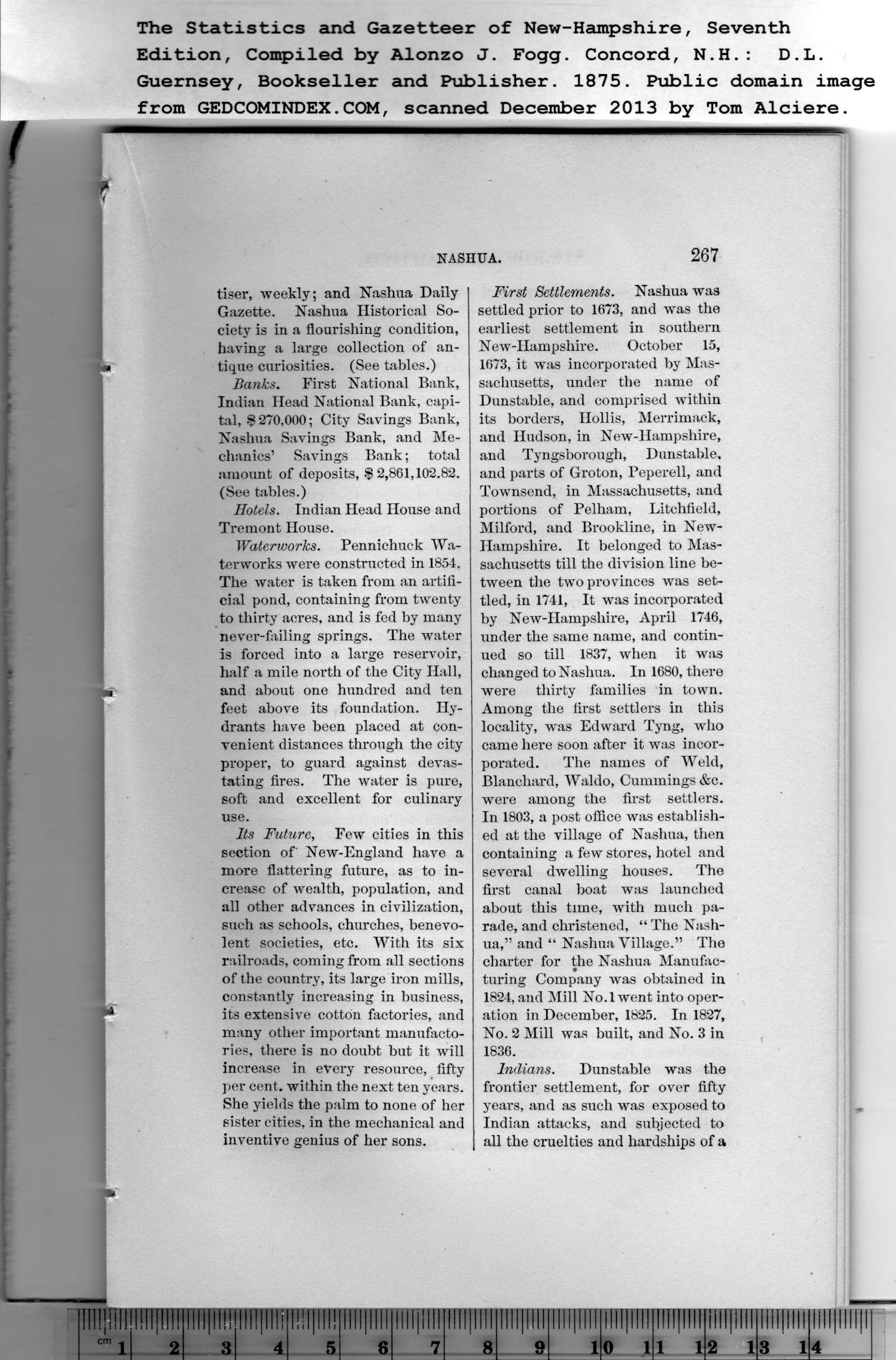|
tiser, weekly; and Nashua Daily
Gazette. Nashua Historical So-
ciety is in a flourishing condition,
having a large collection of an-
tique curiosities. (See tables.)
Banks. First National Bank,
Indian Head National Bank, capi-
tal, $270,000; City Savings Bank,
Nashua Savings Bank, and Me-
chanics’ Savings Bank; total
amount of deposits, $2,861,102.82.
(See tables.)
Hotels. Indian Head House and
Tremont House.
Waterworks. Pennichuck Wa-
terworks were constructed in 1854.
The water is taken from an artifi-
cial pond, containing from twenty
to thirty acres, and is fed by many
never-failing springs. The water
is forced into a large reservoir,
half a mile north of the City Hall,
and about one hundred and ten
feet above its foundation. Hy-
drants have been placed at con-
venient distances through the city
proper, to guard against devas-
tating fires. The water is pure,
soft and excellent for culinary
use.
Its Future, Few cities in this
section of New-England have a
more flattering future, as to in-
crease of wealth, population, and
all other advances in civilization,
such as schools, churches, benevo-
lent societies, etc. With its six
railroads, coming from all sections
of the country, its large iron mills,
constantly increasing in business,
its extensive cotton factories, and
many other important manufacto-
ries, there is no doubt but it will
increase in every resource, fifty
per cent, within the next ten years.
She yields the palm to none of her
sister cities, in the mechanical and
inventive genius of her sons. |
First Settlements. Nashua was
settled prior to 1673, and was the
earliest settlement in southern
New-Hampshire. October 15,
1673, it was incorporated by Mas-
sachusetts, under the name of
Dunstable, and comprised within
its borders, Hollis, Merrimack,
and Hudson, in New-Hampshire,
and Tyngsboi'ough, Dunstable,
and parts of Groton, Peperell, and
Townsend, in Massachusetts, and
portions of Pelham, Litchfield,
Milford, and Brookline, in New-
Hampshire. It belonged to Mas-
sachusetts till the division line be-
tween the two provinces was set-
tled, in 1741, It was incorporated
by New-Hampshire, April 1746,
under the same name, and contin-
ued so till 1837, when it was
changed to Nashua. In 1680, there
were thirty families in town.
Among the first settlers in this
locality, was Edward Tyng, who
came here soon after it was incor-
porated. The names of Weld,
Blanchard, Waldo, Cummings &e.
were among the first settlers.
In 1803, a post office was establish-
ed at the village of Nashua, then
containing a few stores, hotel and
several dwelling houses. The
first canal boat was launched
about this time, with much pa-
rade, and christened, “ The Nash-
ua,” and “ Nashua Village.” The
charter for the Nashua Manufac-
turing Company was obtained in
1824, and Mill No. 1 went into oper-
ation in December, 1825. In 1827,
No. 2 Mill was built, and No. 3 in
1836.
Indians. Dunstable was the
frontier settlement, for over fifty
yeai's, and as such was exposed to
Indian attacks, and subjected to
all the cruelties and hardships of a |
